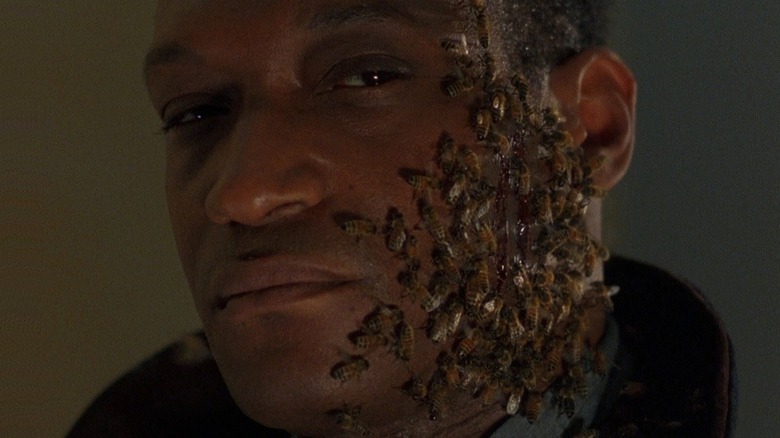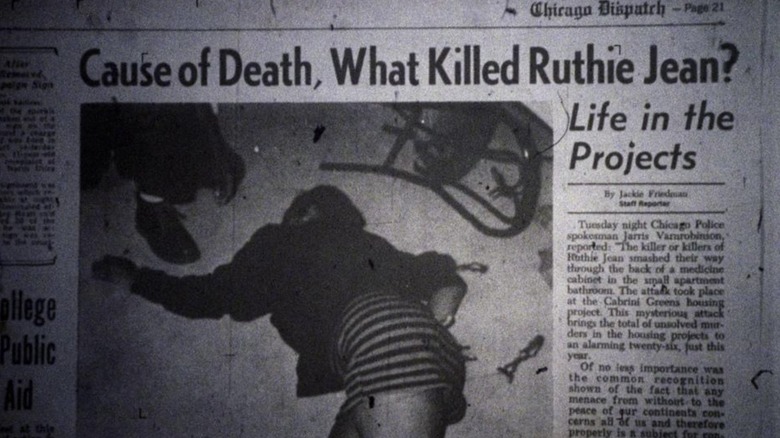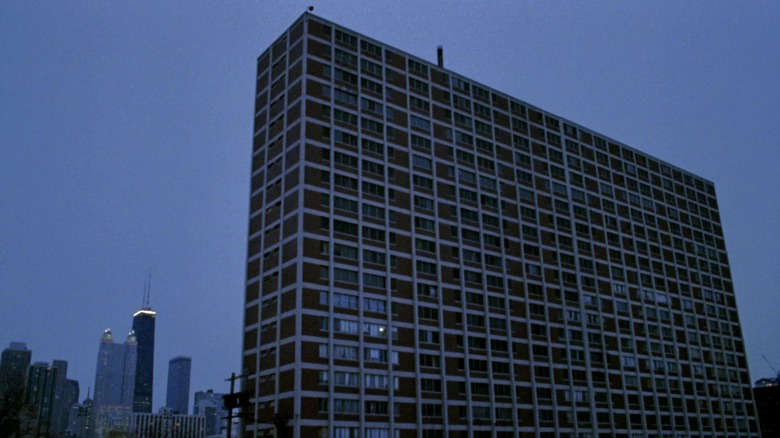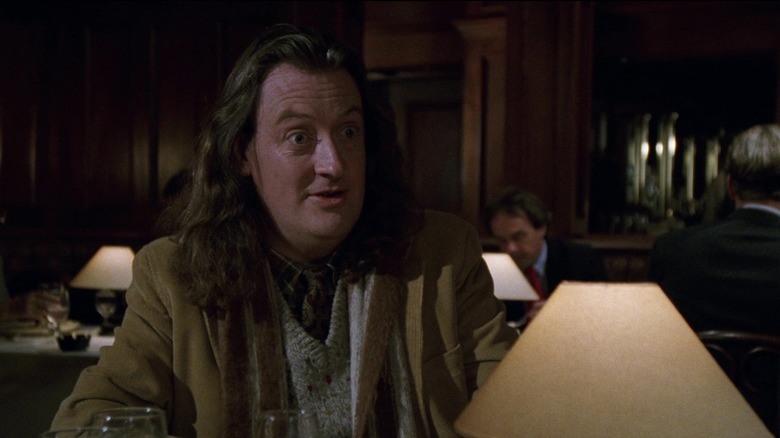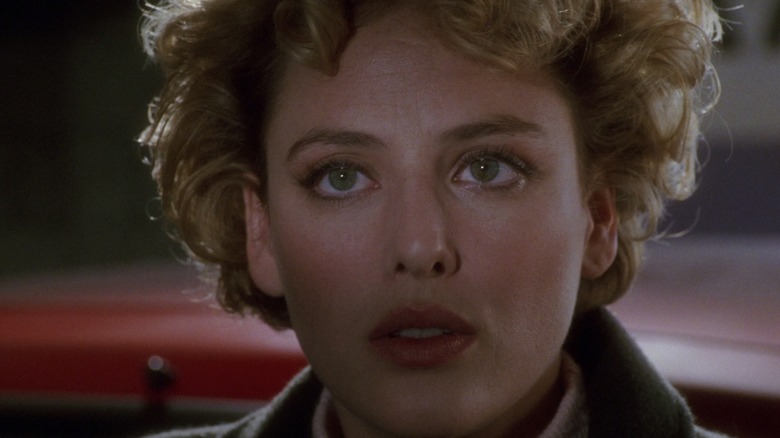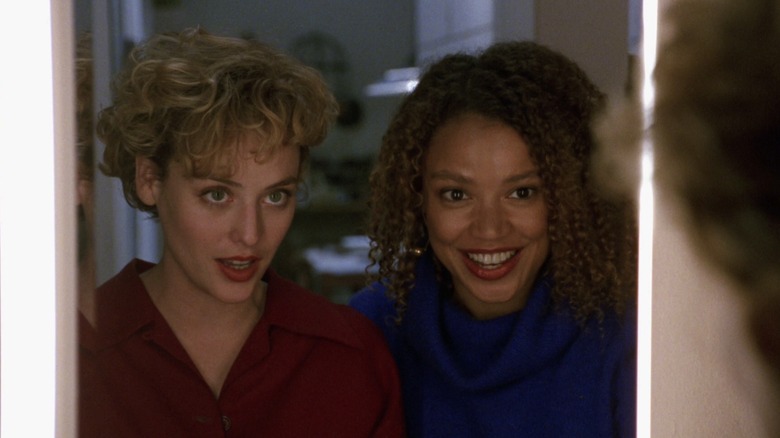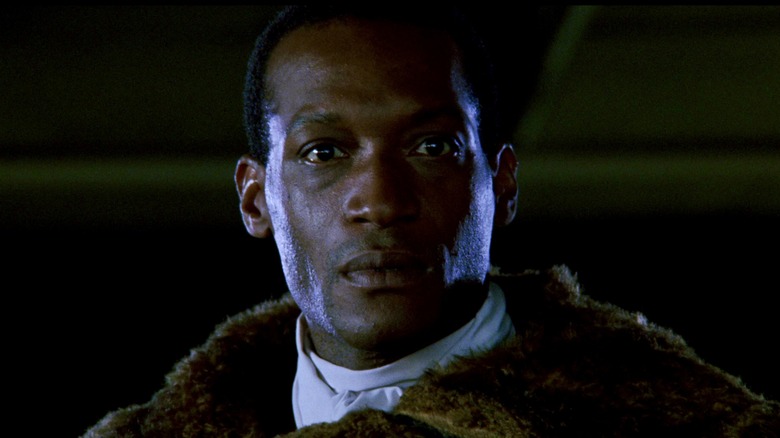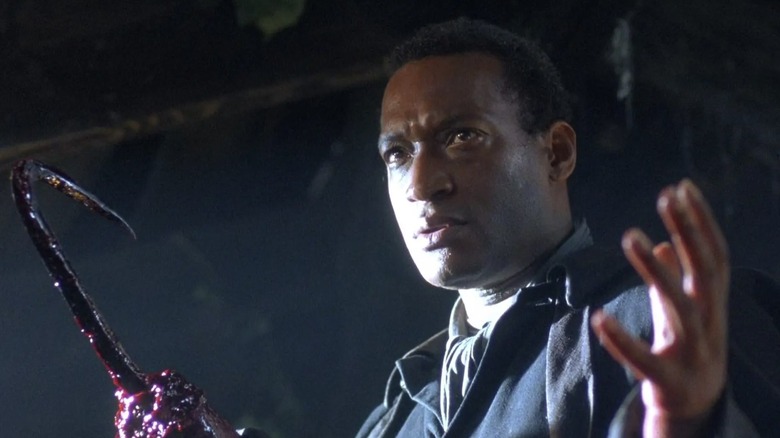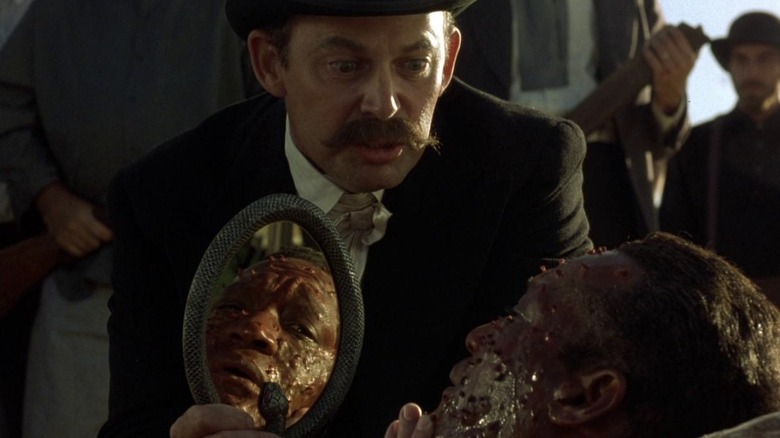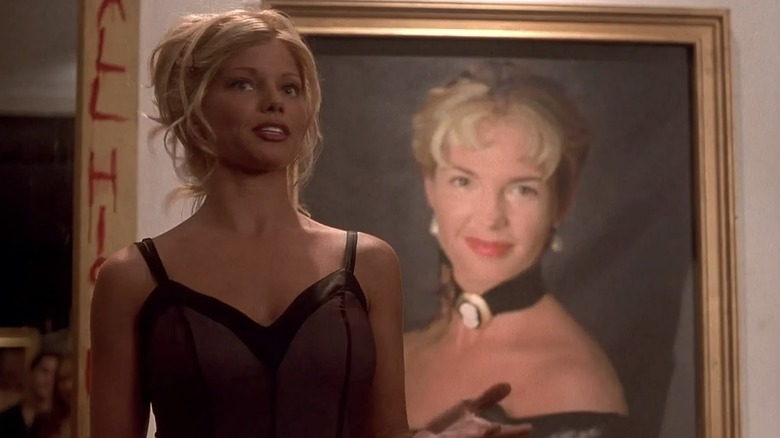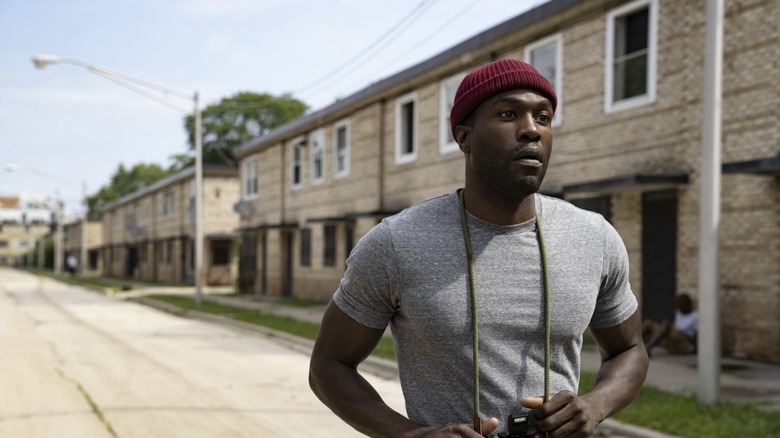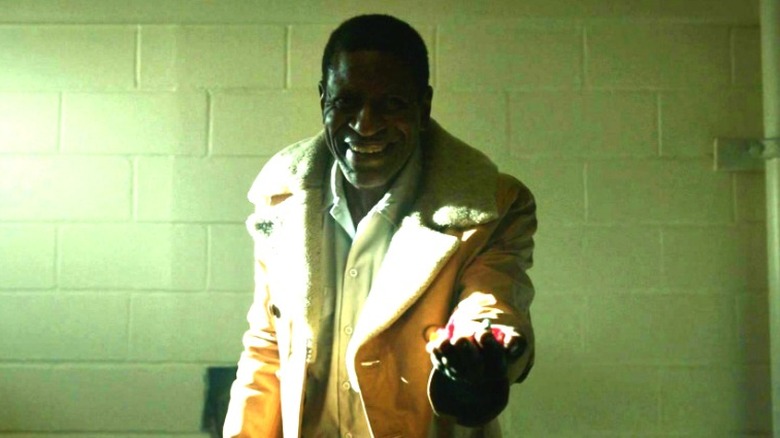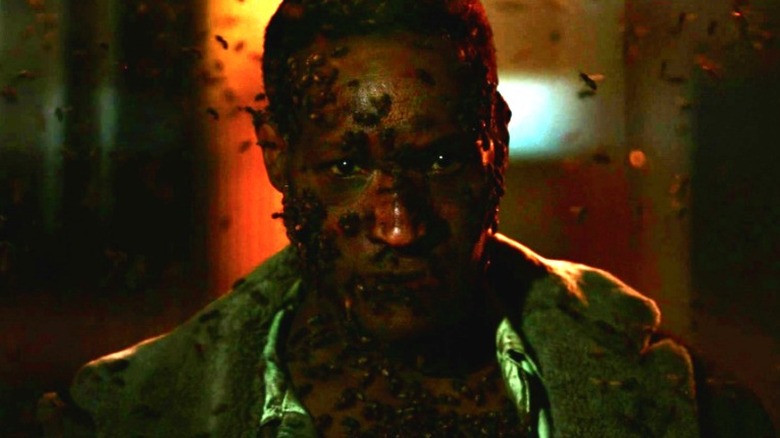The Dark History Of Candyman
Bernard Rose's horror masterpiece "Candyman" tells the haunting story of a man who in life was a talented painter, but in death became a terrifying urban legend about a man with a hook for a hand who will cut you from groin to gullet if you call his name, Candyman, five times in the mirror. The film begins with Helen Lyle (Virginia Madsen) and Bernadette Walsh (Kasi Lemmons), two graduate students at the University of Illinois Chicago, who are researching urban legends for their graduate thesis in the folklore department.
When Helen learns about a connection between the Candyman myth and a real-life murder in the notorious public housing project, Cabrini-Green, she sees an opportunity to turn their thesis into something groundbreaking rather than safe and boring. After visiting Cabrini-Green repeatedly for field work, taking pictures, and collecting stories from residents, Helen is the victim of violence at the hands of a local crime lord who uses Candyman's name to instill fear in the community.
Her disbelief in the legend draws the attention of the real Candyman when she summons him, and he pursues Helen. Candyman frames Helen for the kidnapping of baby Anthony at Cabrini-Green and the murder of Bernadette, crimes he committed to strike fear in the hearts of his believers. Philip Glass's haunting score, the derelict apartments of Cabrini-Green, and Candyman's tragic backstory create a complex villain and a haunting gothic romance. Keep reading to explore the dark history of Candyman, horror's most seductive monster.
British horror writer Clive Barker created Candyman
Clive Barker was born in Liverpool, England, and came to prominence as a horror writer in the mid-'80s with his short story collection, "The Books of Blood." Barker is best known for the "Hellraiser" books that were adapted into a popular film franchise. Volume Five of his collected stories contains "The Forbidden," featuring Candyman, a serial killer responsible for a series of grisly murders in a low-income housing development in Liverpool, England.
In Barker's story, graduate student Helen Buchanan visits the Spector Street Estate to study graffiti for her thesis, "Graffiti: The Semiotics of Urban Despair." Helen is intrigued by the message, "Sweets to the sweet" accompanying candy defiled by razor blades, and a detailed portrait in a vacant flat. Helen meets a resident, Anne-Marie, who tells her about a murder. When Helen's husband Trevor, and their friends from the university doubt the veracity of Anne-Marie's story, Helen becomes obsessed, visiting Spector Street again to speak with other residents.
These women know nothing of the man cut to ribbons, but tell Helen of a mentally disabled boy who was castrated in the public restrooms. Candyman kills Anne-Marie's son and reveals himself to Helen, suggesting he attained immortality as a legend. Candyman seduces Helen into being his victim with hypnotic suggestions and the buzz of bees emanating from his body. As Bloody Disgusting reported, Candyman has no elaborate backstory in Barker's tale, but the 1992 film borrows some of its best lines from this text.
An unsolved murder from 1987 in Chicago bears striking similarities to the first film
The unsolved murder of Ruthie Mae McCoy, who lived in the Grace Abbott Homes on Chicago's south side, may have been an inspiration for the murder that intrigues Helen Lyle, bringing her to Cabrini-Green in the 1992 film. Although the director of "Candyman," Bernard Rose, said nothing publicly, the links between the real-life murder and the scenarios and names of the characters in "Candyman" are too similar to ignore.
In 1987, Chicago journalist Steve Bogira wrote the article, "They Came in Through the Bathroom Mirror" for the Chicago Reader, detailing the murder of McCoy a mentally ill woman killed in her apartment after calling 911, saying someone was coming into her apartment through the bathroom wall. The story of McCoy's death is very similar to the story Kitty Culver (Sarina C. Grant) tells Helen Lyle about the murder of Ruthie Jean in Cabrini-Green.
In 2014, Steve Bogira wrote about the striking similarities between the murder in the film with the one he covered in 1987, as well as the meeting he had with a Hollywood actor interested in making a movie about the story. Although this actor didn't move forward, Bogira saw the similarities between his 1987 story and the film and noticed a similar headline to his 1990 story "Cause of Death" reproduced in the film during Helen's research into Ruthie-Jean's murder.
Bernard Rose brought Candyman to Cabrini-Green housing projects in Chicago
According to Virginia Madsen, who played Helen in "Candyman," the English filmmaker Bernard Rose's wife, Alexandra, showed Barker's short story to Rose. Rose agreed to adapt it, and during development, he took Barker's story out of Liverpool, reimagining Candyman in America. Rose told Horrorella in an interview, it was during a scouting trip to Chicago he decided on Cabrini-Green housing projects as the location of his film after the Illinois Film Commission showed him the neighborhood.
Rose chose Cabrini-Green because "it was a place of such palpable fear," adding, "there was such an aura of fear around the place and I thought that was really something interesting to look into because it's sort of a kind of fear that's at the heart of modern cities." The graffiti-covered buildings and trash-strewn streets were a perfect backdrop for a story about urban decay and disenfranchised communities turning to urban legends to cope with their daily traumas.
According to Time Magazine, in the 19th century, the neighborhood that would later become Cabrini-Green had a long history of poverty and crime. It was once called "Little Hell" because of mafia activity. In 1937, the Chicago Housing Authority was established in response to the Great Depression and the housing crisis that plagued Chicago. Cabrini-Green was built to repair the mistakes of the Housing Authority, and welcomed residents in 1942, but the idealistic vision for the integrated housing project disintegrated.
In the 1992 film, Candyman got a tragic backstory to match the location
Bringing "Candyman" to America and casting Tony Todd in the titular role introduced race to the existing discussion of class in Barker's source material. In Rose's adaptation, Candyman was the son of a former slave who gained wealth after the Civil War. This former slave sent his son to the best schools, and he became an acclaimed painter who was highly sought after for portraits. He fell in love with one of his models and they embarked on an interracial relationship resulting in her pregnancy and his lynching.
According to Film School Rejects, Tony Todd developed Candyman's backstory, transforming him into a tragic figure, during rehearsals with Virginia Madsen after the director encouraged them. It was Todd who decided in 1890 that a mob who sawed his right hand off with a rusty blade and replaced it with a hook before they slathered his naked body with honey and cheered as the bees stung him to death chased the painter down.
As Film School Rejects noted, this dark origin story "makes Candyman's anger and rage feel completely justified." We learn about the urban legend in the 1992 film from Purcell (Michael Culkin), one of the folklore professors at the university during a dinner party. The brutality of his murder visibly affected Helen, mirroring the audience's repulsion and growing empathy for Candyman, who is a romantic figure, as Rose said, in "the Edgar Allan Poe sense."
The 1992 film suggests Helen Lyle is the reincarnation of Candyman's lover
In both "The Forbidden" and the 1992 film, Candyman comes for Helen after she summons him because she doubts his existence, a theme we will discuss later. In both incarnations of the story, Candyman is a murderer who seduces his victim, asking for their consent to "be my victim." Through Candyman's murals depicted in the 1992 film, and the flashes of memory Helen experiences while under Candyman's hypnotic spell, it is inferred Helen is the reincarnation of Caroline, Candyman's lover.
As Kirsten Moana Thompson, a film professor at Seattle University, wrote in her academic paper, "Through the uncanny figure of the doppelgänger or double, 'Candyman' suggests that Helen Lyle is a reincarnation of Caroline, Robitaille's original lover." Helen recognizes she has nowhere left to go but to Candyman when she awakens in Candyman's lair after escaping the mental hospital. She see's Candyman's mural with the words "It was always you Helen" scrawled over the painting.
Helen recognizes herself in the painting of Candyman's lover, understanding not only her connection to him in his life and his mythology. Helen also understands the inevitability of both her death and her immortality as an urban legend herself, Candywoman. Candyman confirms his desire to be spiritually reunited with his lover when he whispers to Helen in the crackling bonfire, "Our bones will soon be ashes and we shall never be separated again."
The 1992 film created Candyman's link to mirrors
There was no mention of mirrors or summoning Candyman by saying his name five times in Clive Barker's "The Forbidden." In Barker's iteration of the story, Helen's doubt and investigations into the stories were enough to call Candyman. It seems Bernard Rose borrowed this trope from Bloody Mary's folktales to give Candyman his means of being summoned by those who doubt him.
As Joe Stubberfield, a psychology lecturer at the University of Winchester, wrote in The Conversation, part of what makes Bloody Mary and Candyman so terrifying is every home, and often every room has a portal through which you can invite them into your home. Despite being created on the land where Cabrini-Green was built, Candyman can travel anywhere outside of the housing project to punish his disbelievers, as he does in the first story Helen records from an undergraduate student at the University of Illinois Chicago.
Alisha Grauso wrote for Atom Tickets Insider about the overlapping and similar origin stories of Bloody Mary, La Llorona, and Candyman, who all share a means of being summoned by their victims. They also share tragic backstories and are depicted as victims of gender or race-based violence. La Llorona is a manifestation of maternal grief, and Candyman is a manifestation of rage. These folktales are interesting explorations of the cycle of abuse, depicting how sometimes a victim later becomes the perpetrator.
Candyman gets his power from his believers
While each iteration of the Candyman legend has, its own perspective on what exactly Candyman is, and where he gets his frightening powers of suggestion, invisibility, and immortality from, the 1992 horror masterpiece stays true to Clive Barker's short story, suggesting Candyman gets his power from those who believe in him. His power comes directly from the urban legends of his gruesome murders.
In both Barker's short story and Rose's adaptation, Candyman comes for Helen because she doubts him: "Your disbelief destroyed the faith of my congregation." We see this theme repeated throughout the other "Candyman" films, although each film has its own twist on the legend. Candyman might be the only movie slasher who asks for consent, saying, "be my victim," raising the question, does Candyman need his victims to believe in him to have the power to kill them?
In the short story and first film, Candyman explains to Helen the liminal space he inhabits, saying, "Why do you want to live? If you had learned just a little from me, you would not beg to live. I am rumor. It is a blessed condition, believe me. To be whispered about at street corners. To live in other people's dreams, but not to have to be. Do you understand?" Explaining to Helen that his form of immortality allows him to exist without the pain of living. In Barker's short story, Helen understands Candyman's offer is to make her "Immortal in gossip and graffiti."
In the second film, we learn Candyman's human name
"Candyman: Farewell to the Flesh" delves deeper into Candyman's backstory and we learn he was born in New Orleans and was named Daniel Robitaille. This movie explores Robitaille's affair with Caroline Sullivan and what happened to Caroline and their unborn daughter Isobel after his death. We also learn he got the nickname Candyman during his lynching when a little boy in the crowd tasted honey from his body before calling him Candyman.
"Farewell to the Flesh" humanizes Candyman, adding to his dark history, by allowing us to see the torture Robitaille experienced, and how his painful death created the vengeful wraith Candyman. After the mysterious murder of her father, and the wrongful arrest of her brother, Annie Tarrant (Kelly Rowan), a New Orleans artist and teacher, thinks her family might be cursed. While trying to clear her brother's name, Annie discovers her mother, Octavia Tarrant (Veronica Cartwright) has been hiding the fact that they are descended from Caroline and Daniel's daughter Isobel.
After Daniel's murder, Caroline left Chicago and moved to New Orleans, purchasing the old plantation house where Daniel was born and raised their daughter, Isobel, who passed for white. Candyman targets the Tarrant family, suggesting that by denying their relationship to him, they actually give him power over their lives. Despite losing her father, brother, mother, and husband to Candyman, Annie teaches her young daughter who her multi-great-grandfather was and doesn't deny this part of herself as her mother did.
Farewell to the Flesh links Candyman's spirit with Caroline Sullivan's mirror
While researching her family history, Annie learns from a New Orleans art dealer of ill-repute, Honore Thibodeaux (Matt Clark), that when her father, Coleman Tarrant (Michael Bergeron), was murdered, he was trying to locate Caroline Sullivan's mirror. Coleman had heard a legend that Daniel Robitaille's spirit was trapped in Caroline's mirror when he died. He believed if he found and destroyed the mirror, Daniel's spirit could rest, and Candyman would be destroyed.
This film humanizes Daniel, showing how he understands what created him. Candyman says to Annie in a pivotal scene, "See how I became the reflection of their hatred, their evil. See what it means to call me by that name." This film also does what people do with oral folktales themselves. The film changes and shapes Candyman's legend to fit a new region, highlighting the particular anxieties of that culture, by exploring the racism of white southern families who are ashamed of and deny their mixed ancestry.
"Farewell to the Flesh" deepens the Candyman legend by elaborating on Candyman's link to mirrors as a summoning device, suggesting his spirit actually lives in the mirrors he uses to travel to his victims. Bill Condon, director of "Candyman: Farewell to the Flesh," said, "People look at mirrors a little differently after seeing 'Candyman.' I'm sure there's a lot of kids that look at mirrors the way another generation reconsidered taking showers after 'Psycho' came out."
Day of the Dead suggests Candyman's spirit lives in his paintings
In the third movie, "Candyman: Day of the Dead," Annie's adult daughter Caroline McKeever (Donna D'Errico), who was named after her multi-great-grandmother Caroline Sullivan, has moved to Los Angeles and is haunted by her mother's death. Intent upon destroying the Candyman legend, Caroline puts together a gallery showing of Daniel Robitaille's paintings, hoping to help people see him as a real man and the victim of a hate crime, rather than the mythical figure Candyman.
When Caroline is dared to say Candyman five times in front of a mirror to prove she doesn't believe the legend at the art show, she concedes, and Candyman comes for her, as he did for Helen and Annie before her. Candyman once again frames Caroline for a series of murders and asks Caroline to "be my victim." This movie is certainly the weakest in the series, but it explores Caroline and Daniel's love affair and it posits another theory about where Candyman's spirit lives and where his power flows from.
A bruja, Abuela (Lupe Ontiveros), advises Caroline to destroy Daniel's paintings to destroy Candyman's spirit, saying "there can be no bad without the good." Caroline destroys his beautiful paintings, which seems like a crime against art. Ultimately, Caroline follows her mother's advice, killing the myth, by pinning the murders on a crooked cop, Samuel Kraft (Wade Williams) who tried to kill her and was in turn killed by a fellow officer.
The 2021 reboot reimagines Candyman as a spirit avenging race-based violence
Nia DaCosta's "Candyman" is a "spiritual sequel" to the 1992 film, ignoring the disappointing second and third films. The reboot is set 29 years after the events of Rose's horror masterpiece. This story centers on the artist, Anthony McCoy (Yahya Abdul-Mateen II), who grew up on Chicago's South side but will soon learn of his personal connection to the history of Cabrini-Green. Anthony recently moved into a luxury high-rise apartment where Cabrini-Green once stood, with his gallerist girlfriend, Brianna Cartwright (Teyonah Parris).
Anthony learns the neighborhood's haunted history, when Brianna's brother, Troy (Nathan Stewart-Jarrett), tells them an urban legend about Helen Lyle, a graduate student, who went on a killing spree while studying the urban legends of Cabrini-Green. Anthony is fascinated by the story and dives into research, finding inspiration for his next painting series about the gentrification and the erasure of Black spaces. When Anthony meets William Burke (Colman Domingo), who grew up in Cabrini-Green, Anthony learns of Candyman's connection to Helen Lyle.
William tells Anthony about the Candyman of his childhood, Sherman Fields (Michael Hargrove), a harmless mentally disabled man accused of putting razor blades in candy. This film anchors the mythology squarely in the Black Lives Matter movement by exploring Candyman as an urban legend rising around Black men who were killed by race-based violence. The myth of Candyman justifies their murders by making them criminals rather than recognizing them as victims. This suggests Candyman's motivation is vengeance.
Nia DaCosta's film affirms that Candyman's power doesn't come from belief
This latest "Candyman" film suggests his power comes not from the fear of those who believe in the myth, but from the hatred fueling the race-based violence responsible for a series of Black men's deaths in Cabrini-Green. These men became, in death, avenging spirits fueled by the ambient hatred behind the racism that killed them through police brutality and hate-crimes.
William tells Anthony about Daniel Robitaille, who was lynched on the grounds where Cabrini-Green would be, saying, "The big finale, they set him on fire and he finally dies. But a story like that, a pain like that, lasts forever. That's Candyman." William adds the names of real-life incidents that happened at Cabrini-Green, adding names to the list, saying, "Bell is real. Samuel, Sherman, Daniel Robitaille, They're all real. Candyman is how we deal with the fact these things happened. That they're still happening." Film professor Kirsten Moana Thompson, wrote, "Born of torture, mutilation, and homicide, Candyman is a rare example of the horror genre's interrogation of historical lynchings."
The writers of this newest incarnation of "Candyman" suggest, through William's traumatized and unstable character, that Candyman was created and gets his power from the physical, emotional, and psychic pain of those murdered Black men and the community that lost them to racial violence. William's twisted motivation to make Anthony the next Candyman is an attempt to take the power back for his community, turning the tables on the police, who brutalized them.
The dark history of Candyman began with America's original sin
Candyman's dark origins are tied directly to the United States' history of slavery, the racism that was developed, and the hatred stoked to condone the barbaric practice (per Stamped from the Beginning). Much like Barker's short story "The Forbidden" explores the social function of folktales, Candyman has become a horror icon because he is a conduit to examine our cultural anxieties about generational traumas from our history of slavery and continued institutionalized racism.
The most recent "Candyman" film continues this exploration of urban legends from the original film, by twisting Helen Lyle's story, one Anthony McCoy was at the center of as a baby, like a game of telephone twists a phrase. DaCosta's film is an exploration of the gentrification cycle and the commodification of Black pain, but it is most successful when it incorporates well-known urban legends with real-life urban tragedies to create a new myth around Candyman when he returns to save Brianna from the police rather than kill her.
Film professor Kirsten Moana Thompson, wrote, "Candyman is the return of the repressed as national allegory, for the monstrous hookman brings with him a history of racism, miscegenation, slavery, and lynching-the taboo secrets of America's past and present." In the film's last scene, after Candyman kills the police officers who killed Anthony, Tony Todd reprises his role as Candyman, leaving Brianna and the audience with one final message: "Tell everyone" Candyman is back."
